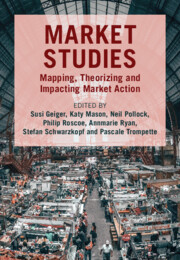Book contents
- Market Studies
- Market Studies
- Copyright page
- Contents
- Figures
- Tables
- Contributors
- Acknowledgements
- Introduction: The Multiple Pasts, Presents and Futures of Markets and Market Studies
- Part I Market Designs and Market Misfires
- Part II Post-Performative Approaches to Studying Markets
- Chapter 6 The Performativity Test
- Chapter 7 Performative Struggles and Theory–Practice Decoupling in the Design and the Implementation of a Market-Based Instrument: French Tradable Certificates for Energy Efficiency
- Chapter 8 Nudging as a Tool of Market Design and Profitability: Performativity in the Age of Behavioural Economics
- Chapter 9 The Social Life of Simulated Markets: A Market Studies Approach
- Part III Valuation
- Part IV Markets in Motion: Places and Spaces
- Part V The Secret Life of Market Studies Methods
- Part VI Broadening the Perspectives in Market Studies
- Part VII Future (Im)Perfect Markets
- Index
- References
Chapter 9 - The Social Life of Simulated Markets: A Market Studies Approach
from Part II - Post-Performative Approaches to Studying Markets
Published online by Cambridge University Press: 22 November 2024
- Market Studies
- Market Studies
- Copyright page
- Contents
- Figures
- Tables
- Contributors
- Acknowledgements
- Introduction: The Multiple Pasts, Presents and Futures of Markets and Market Studies
- Part I Market Designs and Market Misfires
- Part II Post-Performative Approaches to Studying Markets
- Chapter 6 The Performativity Test
- Chapter 7 Performative Struggles and Theory–Practice Decoupling in the Design and the Implementation of a Market-Based Instrument: French Tradable Certificates for Energy Efficiency
- Chapter 8 Nudging as a Tool of Market Design and Profitability: Performativity in the Age of Behavioural Economics
- Chapter 9 The Social Life of Simulated Markets: A Market Studies Approach
- Part III Valuation
- Part IV Markets in Motion: Places and Spaces
- Part V The Secret Life of Market Studies Methods
- Part VI Broadening the Perspectives in Market Studies
- Part VII Future (Im)Perfect Markets
- Index
- References
Summary
Simulated markets are a fascinating paradox for Market Studies. They are markets organized around nothing. No real property rights get exchanged when markets are “only” simulated. They are unproductive in the sense that simulated markets produce no surplus for anyone. They are markets that do not actually exist. Yet, simulations of market processes play an increasingly important role in market practices as well as in wider business pedagogy. This chapter uses historical and contemporary evidence on the development and uses of market simulations in various settings – ranging from business schools to Wall Street – to test the post-performativity paradigm in Market Studies. The chapter shows that real-world market arrangements are changed not with the help of economic models, economic theories or economists themselves, but rather through business school teachers, family accountants, software tinkerers and designs that emerged completely outside the sphere of economic theory and modelling. By studying the early uses of electronic spreadsheets for market simulations, we can see that market arrangements require calculative communities rather than economists.
- Type
- Chapter
- Information
- Market StudiesMapping, Theorizing and Impacting Market Action, pp. 144 - 160Publisher: Cambridge University PressPrint publication year: 2024

